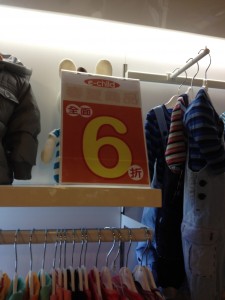As would be the case if we were in any other part of the world, one thing that we do regularly is go shopping. With all the malls and shopping centers and department stores here in Kaohsiung, it’s pretty easy to spend a whole afternoon looking for great deals.
This past weekend we wanted to do a bit of Christmas shopping so we decided to check out Eda, which is a new outlet mall, amusement park and hotel complex located about a 20 minute bus ride from the center of Kaohsiung.
An outlet mall, an amusement park and a hotel. All in one place. How awesome is that?
Anyway, like in any materialistic society, Christmas sales are in abundance here as well (even though they don’t actually celebrate Christmas here… more on that in another post).
However, one thing that took me a while to figure out: how much is something *actually* on sale for?
So 200 points for someone who can answer this on the first try: what does the following mean?
If you thought… oh, it means everything here is $6. Nope.
How about: 6% off? Negative.
Or: Take 6… and run as fast as you can away from the security guard that’s running after you!? No. Well, maybe… but no.
Give up yet?
It means… 40% off!
No… not 60% off as you might be able to guess… but 40% off.
Yeah. That’s right. A big “6″ on the sign means 40% off.
Basically, what the number is telling you is that prices are marked at so-many tenths of what it originally is. Got that?
Hmm… okay, for those that need a little bit of further assistance with this, I’ve come up with a formula which you can feel free to commit to memory next time you decide to come shopping on the island of Formosa.
p = 10 * (10 – x)
Where p is the “% off”, and x is the number that you see on the sign.
Is that better?
If not, or if you are having trouble committing the above formula to memory… please wait a few months and I’ll put up my “Help Me Understand This Sale Price in Taiwan” app up on the App Store.


